Lincoln Navigator: Fuel Charging and Controls - 3.5L EcoBoost (272kW/370PS) / Port Injection Fuel Rail. Removal and Installation
Lincoln Navigator 2018-2025 Workshop Manual / Engine / Fuel Charging and Controls - 3.5L EcoBoost (272kW/370PS) / Port Injection Fuel Rail. Removal and Installation
Removal
-
Release the fuel system pressure.
Refer to: Fuel System Pressure Release (310-00 Fuel System - General Information - 3.5L EcoBoost (272kW/370PS), General Procedures).
-
Disconnect the battery negative cable.
Refer to: Battery Disconnect and Connect (414-01 Battery, Mounting and Cables, General Procedures).
-
Remove the intake manifold.
Refer to: Intake Manifold (303-01 Engine - 3.5L EcoBoost (272kW/370PS), Removal and Installation).
-
Disconnect the fuel rail fuel tube quick release coupling.
Refer to: Quick Release Coupling (310-00 Fuel System - General Information - 3.5L EcoBoost (272kW/370PS), General Procedures).
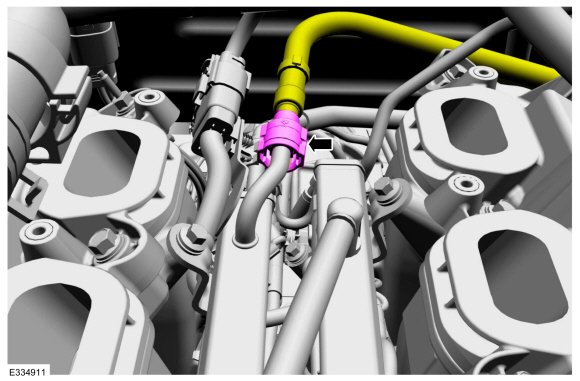 |
-
Disconnect the fuel rail fuel tube quick release coupling.
Refer to: Quick Release Coupling (310-00 Fuel System - General Information - 3.5L EcoBoost (272kW/370PS), General Procedures).
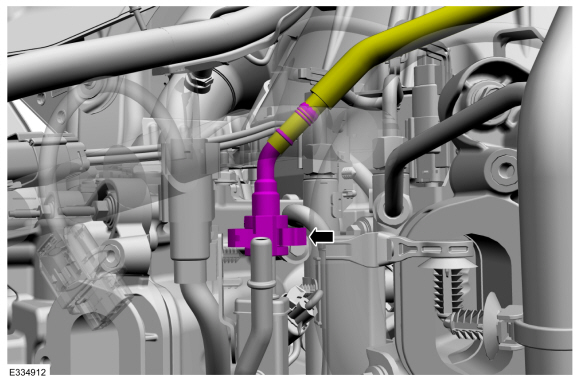 |
-
Disconnect the main fuel injector harness electrical connector.
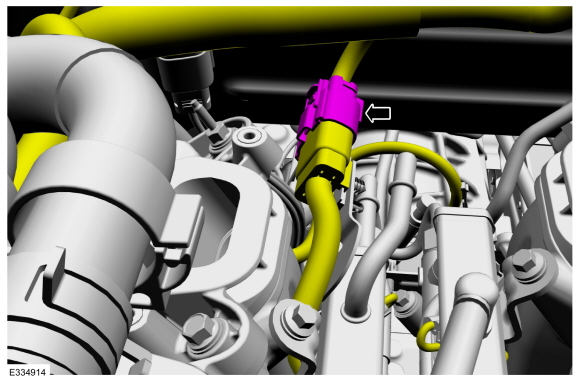 |
-
Remove the fuel rail bolts, then remove the fuel rail.
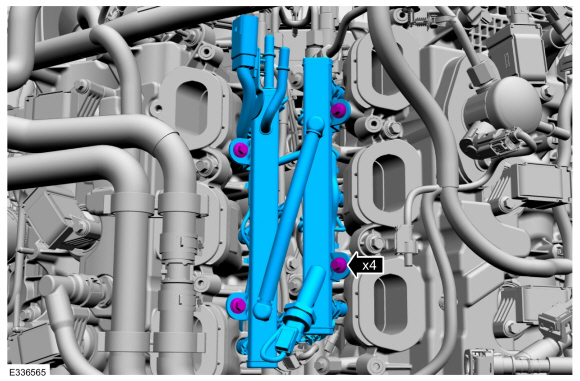 |
-
Disconnect the fuel injector electrical connectors.
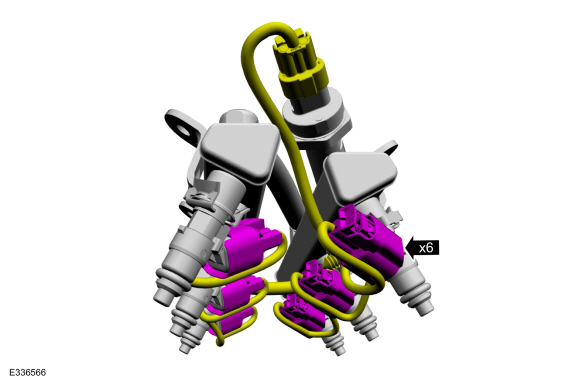 |
-
-
Remove the fuel injector retaining clips.
-
Remove the fuel injectors from the fuel rail.
-
Remove the fuel injector retaining clips.
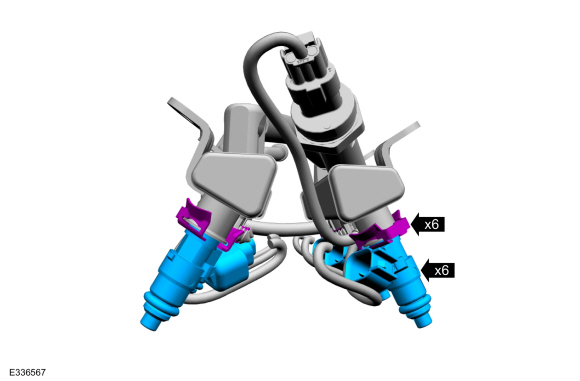 |
-
Remove and discard all of the fuel injector O-ring seals.
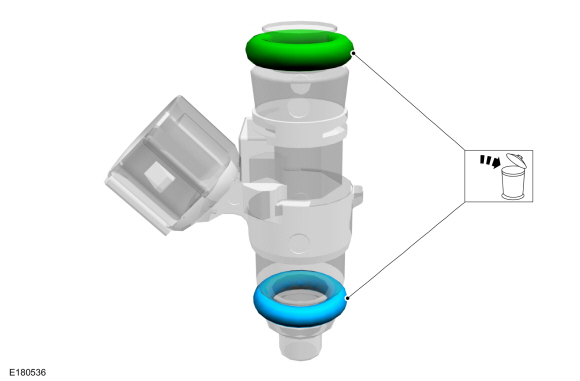 |
Installation
-
NOTE: Make sure that new fuel injector O-ring seals are installed.
-
NOTE: The fuel injector clip can be reused if it is not damaged during removal.
If the clip is reused, the 2 sides of the clip should be squeezed back into shape by placing it between index finger and thumb.
-
Install the new fuel injector O-ring seals and the
fuel injector retaining clips onto the fuel injectors. Lubricate the new
fuel injector O-ring seals with clean engine oil.
Refer to: Specifications (303-01) .
-
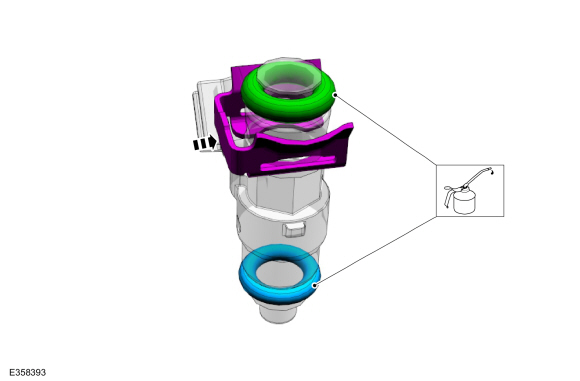 |
-
Install the fuel injectors into the fuel rail.
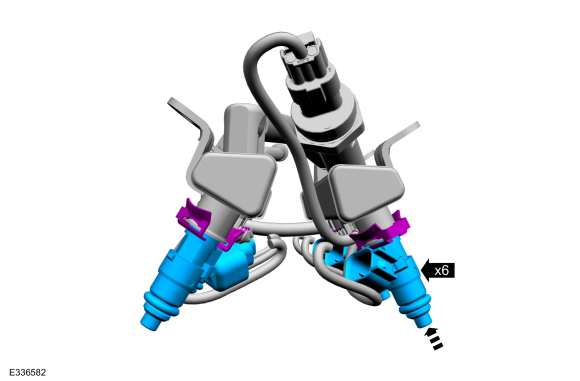 |
-
Connect the fuel injector electrical connectors.
 |
-
Install the fuel rail, then install and tighten the fuel rail bolts in the following 2 stages.
Torque:
Stage 1: Tighten to: : 89 lb.in (10 Nm)
Stage 2: Tighten an additional: : 45°
 |
-
Connect the main fuel injector harness electrical connector.
 |
-
Connect the fuel rail fuel tube quick release coupling.
Refer to: Quick Release Coupling (310-00 Fuel System - General Information - 3.5L EcoBoost (272kW/370PS), General Procedures).
 |
-
Connect the fuel rail fuel tube quick release coupling.
Refer to: Quick Release Coupling (310-00 Fuel System - General Information - 3.5L EcoBoost (272kW/370PS), General Procedures).
 |
-
Install the intake manifold.
Refer to: Intake Manifold (303-01 Engine - 3.5L EcoBoost (272kW/370PS), Removal and Installation).
-
Connect the battery negative cable.
Refer to: Battery Disconnect and Connect (414-01 Battery, Mounting and Cables, General Procedures).
-
Pressurize the fuel system.
Refer to: Fuel System Pressure Release (310-00 Fuel System - General Information - 3.5L EcoBoost (272kW/370PS), General Procedures).
 High-Pressure Fuel Pump Drive Unit. Removal and Installation
High-Pressure Fuel Pump Drive Unit. Removal and Installation
Removal and Installation
The high-pressure fuel pump drive unit is part of the right cylinder head.
Refer to: Cylinder Head RH (303-01 Engine - 3...
 Throttle Body. Removal and Installation
Throttle Body. Removal and Installation
Removal
NOTICE:
The turbocharger compressor vanes can be damaged by even the
smallest particles. When removing any turbocharger or engine air intake
system component, ensure that no debris enters the system...
Other information:
Lincoln Navigator 2018-2025 Workshop Manual: Wheel to Hub Runout Minimization. General Procedures
Check NOTE: Wheel-to-hub optimization is important. Clearance between the wheel and hub can be used to offset or neutralize the Road Force® or run-out of the wheel and tire assembly. For every 0.001 inch of wheel-to-hub clearance, the Road Force® can be affected between 1 and 3 pounds depending on the tire stiffness...
Lincoln Navigator 2018-2025 Workshop Manual: Turbocharger. Diagnosis and Testing
Pinpoint Tests PINPOINT TEST A: BLUE SMOKE FROM EXHAUST Possible Sources Oil leak Air cleaner Air intake Crankcase ventilation system Internal engine damage Turbocharger A1 CHECK THE EXHAUST Start the engine...
Categories
- Manuals Home
- 4th Gen Lincoln Navigator Service Manual (2018 - 2025)
- All Terrain Control Module (ATCM). Removal and Installation
- Brake Service Mode Activation and Deactivation. General Procedures
- SYNC Module [APIM]. Removal and Installation
- Power Running Board (PRB). Diagnosis and Testing
- Transmission Fluid Level Check. General Procedures
Front Driveshaft. Removal and Installation
Special Tool(s) / General Equipment
Crimping ToolMaterials
Name Specification Motorcraft® Premium Long-Life GreaseXG-1-E1 ESA-M1C75-B
Removal
With the vehicle in NEUTRAL, position the vehicle on a hoist.Refer to: Jacking and Lifting (100-02 Jacking and Lifting, Description and Operation).
Remove the bolts and the transmission shield.
Copyright © 2025 www.linavigator4.com
